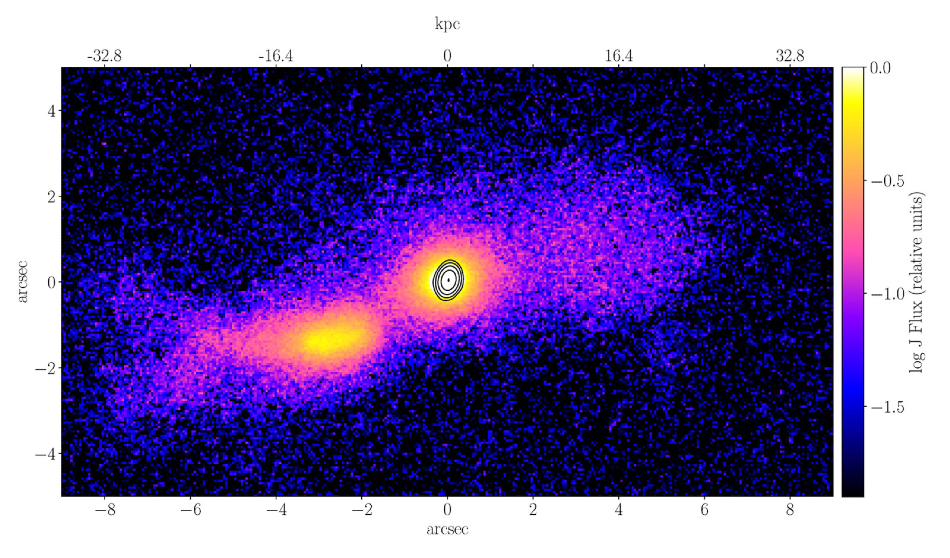Apr 8 2020
In association with international collaborators, a team of researchers from the College of Science at Clemson University has reported the first conclusive detection of a relativistic jet emanating from a pair of colliding galaxies.
 The Seyfert 1 galaxy, TXS 2116-077, (seen on the right) collides with another spiral-shaped galaxy of similar mass, creating a relativistic jet in the TXS’s center. Both galaxies have active galactic nuclei (AGN). Image Credit: Courtesy Vaidehi Paliya.
The Seyfert 1 galaxy, TXS 2116-077, (seen on the right) collides with another spiral-shaped galaxy of similar mass, creating a relativistic jet in the TXS’s center. Both galaxies have active galactic nuclei (AGN). Image Credit: Courtesy Vaidehi Paliya.
This is the first-ever photographic evidence to show that the colliding galaxies are capable of releasing jets of charged particles that move at almost the speed of light.
Earlier, researchers had also discovered that elliptical-shaped galaxies may also contain these jets of charged particles. Such elliptical-shaped galaxies can form when two spiral galaxies combine together. The researchers have an image that reveals how a jet is formed from a couple of younger, spiral-shaped galaxies.
For the first time, we have found two spiral- or disk-shaped galaxies on path for a collision that have produced a nascent, baby jet that has just started its life at the center of one of the galaxies.
Vaidehi Paliya, Study Lead Author and Former Postdoctoral Researcher, Clemson University
The findings were published in The Astrophysical Journal on April 7th, 2020. The study is titled “TXS 2116-077: A gamma-ray emitting relativistic jet hosted in a galaxy merger.”
Apart from Paliya, who is currently at Germany-based Deutsches Elektronen Synchrotron (DESY), the other authors from Clemson University include associate professor Marco Ajello, professor Dieter Hartmann, and also Stefano Marchesi, an adjunct professor from the department of physics and astronomy.
Since the jet is extremely young, the scientists were able to clearly visualize its host. Ajello informed that such galactic collisions have been previously imaged by other researchers a number of times.
However, Ajello and his collaborators were the first to image the merging of two galaxies and a completely formed jet that is pointing at the earth.
Typically, a jet emits light that is so powerful we can’t see the galaxy behind it. It’s like trying to look at an object and someone points a bright flashlight into your eyes. All you can see is the flashlight. This jet is less powerful, so we can actually see the galaxy where it is born.
Stefano Marchesi, Adjunct Professor, Department of Physics and Astronomy, Clemson University
Jets are known to be the most intense astrophysical phenomena that occur in the universe. They are capable of releasing extreme amounts of energy into the universe in just a single second when compared to the energy produced by the Sun in its whole lifetime. The said energy occurs in the form of radiation, like powerful radio waves, gamma-rays, and X-rays.
“Jets are the best accelerators in the universe—far better than the super colliders we have on Earth,” Hartmann added, referring to accelerators that are employed in high-energy physics studies.
It was believed that jets evolved from older, elliptical-shaped galaxies that have an active galactic nucleus (AGN)—a giant black hole that dwells at its core. As a reference point, researchers assume that all galaxies contain centrally located giant black holes but all of them are not AGNs. For instance, the giant black hole is dormant in the Milky Way.
Researchers hypothesized that by gravitationally pulling dust and gas via a process known as accretion, the AGNs eventually become larger. However, the entire matter does not get accumulated inside the black hole. A few particles become accelerated and are expelled outwards in contracted beams in the form of jets.
It’s hard to dislodge gas from the galaxy and have it reach its center. You need something to shake the galaxy a little bit to make the gas get there. The merging or colliding of galaxies is the easiest way to move the gas, and if enough gas moves, then the super-massive black hole will become extremely bright and could potentially develop a jet.
Marco Ajello, Associate Professor, Department of Astronomy and Astrophysics, Clemson University
According to Ajello, the researchers’ photograph effectively captured a pair of galaxies—a Seyfert 1 galaxy called TXS 2116-077 and another galaxy of analogous mass, as they were merging for the second time due to the proportion of gas observed in the image.
“Eventually, all the gas will be expelled into space, and without gas, a galaxy cannot form stars anymore,” Ajello added. “Without gas, the black hole will switch off and the galaxy will lay dormant.”
The Milky Way will combine with the neighboring Andromeda galaxy billions of years from now.
“Scientists have carried out detailed numerical simulations and predicted that this event may ultimately lead to the formation of one giant elliptical galaxy,” added Paliya. “Depending on the physical conditions, it may host a relativistic jet, but that’s in the distant future.”
The researchers captured the image using Subaru 8.2-m optical infrared telescope—one of the world’s largest land-based telescopes installed on a mountain summit in Hawaii.
The team carried out further observations using the William Herschel Telescope and Gran Telescopio Canarias located on the island of La Palma off the coast of Spain, and also using the Chandra X-ray Observatory space telescope of NASA.
The study was financially supported by the Smithsonian Astrophysical Observatory via grant DD8-19104X.